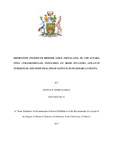Dissipation Studies of Ridomil Gold (Metalaxyl M) and Actara 25wg (Thiamethoxam) Pesticides on Irish Potatoes (Solanum Tuberosum) and Snow Peas (Pisum Sativum) in Nyandarua County.
Abstract
The main objective of this study was to assess the dissipation rates of methyl N-(methoxyacetyl)-N-(2, 6-xylyl)-D-alaninate (ridomil gold; metalaxyl M) and 3-(2-chloro-1, 3-thiazol-5-ylmethyl)-5-methyl-[1, 3, 5]-oxadiazinan-4-yllidine (nitro) amine (Actara 25WG; thiamethoxam) pesticides applied on potatoes and snow peas in Nyandarua County where potatoes and snow peas farming are ventures that are helping the small scale farmers to boost their income. However, the yields are profoundly affected by fungi and insect pest. The average yield of <10 t/ha is low compared to 40-50 t/ha obtained in countries with well-developed potato production system in America and Europe. Pesticides are very important in agriculture in Kenya because of decreasing quality and quantity of crop production due to diseases and pest infestations. Whereas pesticides are capable of controlling crops and livestock diseases and pests, they are also poisons that can affect non-target organisms such as human and wildlife. Farmers in Nyandarua County had registered complaints about lack of effectiveness of the Ridomil Gold used to control fungi on potatoes. In addition, stringent regulations in the European market limit the maximum residual levels on exported products that have seen the rejection of Kenyan snow peas from the EU market due to high residues of pesticides.
Samples were collected and Soxhlet extracted using organic solvents, and quantified for Metalaxyl M using GC-MS while Thiamethoxam was analysed using GC-FID. The half-lives of Metalaxyl M and Thiamethoxam dissipation were calculated using the Langmuir-Hinshelwood kinetic model equation and regression curves drawn to get the rate constants. Results obtained showed Metalaxyl M dissipation half-life of 3.13 days and 3.61 days in potatoes and soil, respectively, while Thiamethoxam had a dissipation half- life of 9.34 days and 13.13 days in snow peas and soil, respectively.
vi
The concentration of on thiamethoxam on snow peas on the pre-harvest interval (PHI) day was lower than both the EU and Codex MRLs. Metalaxyl M residues on potato leaves after day 7 were below the limit of detection, clearly indicating that after day 7 the pesticide is not effective to control the early and late blight. All the potato samples collected from the three markets (Njabini, Kiburu and Tulaga) open air markets had Metalaxyl M residues below detection limit. The concentrations of Thiamethoxam residues during wet season were 0.44 mg/Kg, 0.41 mg/Kg and <LOD for Njabini, Kiburu and Tulaga, respectively, while during the dry season the levels were 0.49 mg/Kg, 0.46 mg/Kg and 0.43 mg/Kg, respectively. The results revealed higher pesticide concentrations during the dry season. The most commonly used pesticides in the region were organophosphates, carbamates and pyrethroids. Despite the fact that they are highly toxic compounds, most farmers in the study area did not adhere to the guidelines on the safe use of pesticides. The findings of this study revealed that lack of appropriate data on dissipation rates and proper use of pesticides contributed to ineffective control of pest and high maximum residual levels in post-harvest products.
Publisher
University of Nairobi
Subject
Pesticides on Irish PotatoesRights
Attribution-NonCommercial-NoDerivs 3.0 United StatesUsage Rights
http://creativecommons.org/licenses/by-nc-nd/3.0/us/Collections
The following license files are associated with this item:


